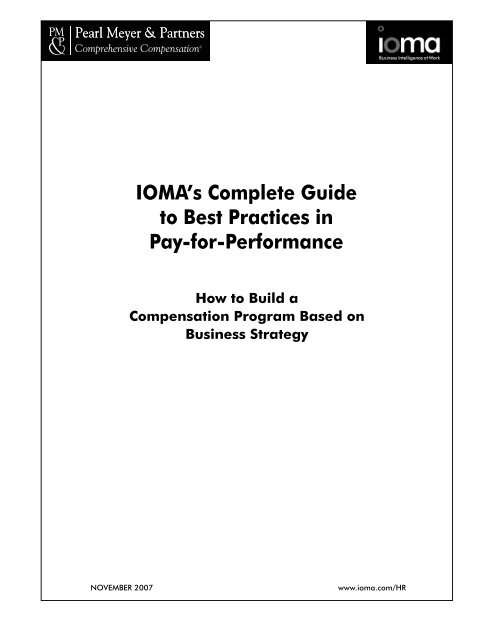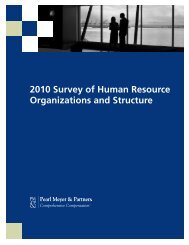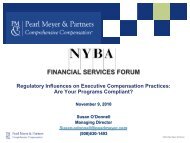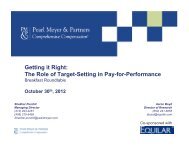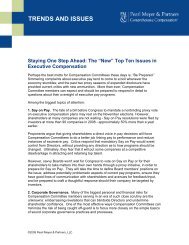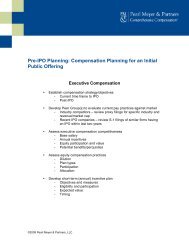IOMA's Complete Guide to Best Practices in Pay-for-Performance
IOMA's Complete Guide to Best Practices in Pay-for-Performance
IOMA's Complete Guide to Best Practices in Pay-for-Performance
Create successful ePaper yourself
Turn your PDF publications into a flip-book with our unique Google optimized e-Paper software.
IOMA’s <strong>Complete</strong> <strong>Guide</strong><br />
<strong>to</strong> <strong>Best</strong> <strong>Practices</strong> <strong>in</strong><br />
<strong>Pay</strong>-<strong>for</strong>-Per<strong>for</strong>mance<br />
How <strong>to</strong> Build a<br />
Compensation Program Based on<br />
Bus<strong>in</strong>ess Strategy<br />
NOVEMBER 2007<br />
www.ioma.com/HR
IOMA’s COMPLETE GUIDE TO BEST PRACTICES IN PAY-FOR-PERFORMANCE<br />
The best way <strong>to</strong> ensure that your compensation<br />
strategy is “right on the money” is <strong>to</strong> make it a<br />
direct extension of your bus<strong>in</strong>ess strategy, stresses<br />
Jim Hudner, Manag<strong>in</strong>g Direc<strong>to</strong>r at compensation<br />
consultancy Pearl Meyer & Partners (www.pearl<br />
meyer.com). “Compensation is a powerful way <strong>to</strong><br />
communicate messages <strong>to</strong> employees about how<br />
they should conduct themselves on the job. Their<br />
actions and behavior are what drive bus<strong>in</strong>ess results,”<br />
he notes. The way you pay them—and the<br />
th<strong>in</strong>gs you pay them <strong>for</strong>—tells them precisely what<br />
behavior you want <strong>to</strong> see.<br />
“If compensation programs are not l<strong>in</strong>ked with<br />
bus<strong>in</strong>ess strategies, you may discourage the right<br />
behavior—or even encourage the wrong behavior,”<br />
Hudner warns.<br />
Hudner acknowledges that all organizations<br />
struggle <strong>to</strong> make the all-important l<strong>in</strong>k between<br />
bus<strong>in</strong>ess strategy and comp strategy, especially at<br />
the non-executive level. “It is much easier <strong>to</strong> make<br />
a direct connection at the executive level, s<strong>in</strong>ce<br />
senior leaders have the ability <strong>to</strong> make changes<br />
that directly impact the bus<strong>in</strong>ess and the clearest<br />
l<strong>in</strong>e of sight,” he expla<strong>in</strong>s. “At many companies,<br />
however, that impact dim<strong>in</strong>ishes as you move down<br />
<strong>in</strong> the organization.”<br />
Here are Hudner’s recommendations <strong>for</strong> build<strong>in</strong>g<br />
a compensation strategy that is effectively<br />
l<strong>in</strong>ked <strong>to</strong> your bus<strong>in</strong>ess strategy throughout the<br />
organization:<br />
Clearly determ<strong>in</strong>e your bus<strong>in</strong>ess’s competitive<br />
focus. “This starts with the HR/compensation<br />
direc<strong>to</strong>r sitt<strong>in</strong>g down with senior leadership <strong>to</strong> p<strong>in</strong>po<strong>in</strong>t<br />
the basis on which your company is compet<strong>in</strong>g<br />
<strong>in</strong> the marketplace. ‘What is our organization’s<br />
competitive advantage? Why will cus<strong>to</strong>mers use<br />
our goods and services?’” Hudner says.<br />
For example, you may compete primarily on<br />
cost, differentiation <strong>in</strong> the market (<strong>to</strong> appeal <strong>to</strong><br />
mass consumers), cus<strong>to</strong>mer focus (the best service<br />
<strong>in</strong> the bus<strong>in</strong>ess), or reputation with<strong>in</strong> a specific<br />
niche market.<br />
“Your compensation plan needs <strong>to</strong> take those<br />
competitive fac<strong>to</strong>rs <strong>in</strong><strong>to</strong> account first,” Hudner<br />
advises. “For example, if you’re compet<strong>in</strong>g on<br />
cost, us<strong>in</strong>g a 75th percentile pay position<strong>in</strong>g <strong>for</strong><br />
most of your population would conflict with your<br />
bus<strong>in</strong>ess strategy.”<br />
Tip <strong>for</strong> success: “Def<strong>in</strong>e those areas/discipl<strong>in</strong>es<br />
<strong>in</strong> which your organization absolutely must excel <strong>in</strong><br />
order <strong>to</strong> execute your bus<strong>in</strong>ess strategy, whether it<br />
is market<strong>in</strong>g, sales, research, <strong>in</strong>novation, etc. These<br />
are the priority behaviors you need <strong>to</strong> reward,”<br />
Hudner says.<br />
Def<strong>in</strong>e your competitive position vis-à-vis<br />
compensation. “Def<strong>in</strong>e the competitive posture<br />
at which your organization needs <strong>to</strong> compete <strong>for</strong><br />
different segments of the employee population,”<br />
Hudner says. “For example, do you need <strong>to</strong> be at,<br />
below, or above market?<br />
“Also, identify with whom your organization<br />
competes <strong>for</strong> personnel. The talent pool is not<br />
homogeneous <strong>for</strong> most organizations: <strong>for</strong> example,<br />
large, complex health-care organizations compete<br />
<strong>in</strong> a specialized market <strong>for</strong> nurses and medical<br />
technicians, but must vie with general <strong>in</strong>dustry <strong>for</strong><br />
f<strong>in</strong>ance and HR talent.<br />
“You then need <strong>to</strong> determ<strong>in</strong>e how <strong>to</strong> most effectively<br />
allocate your compensation dollars among<br />
base salary, short-term and long-term <strong>in</strong>centives.<br />
For example, asset-management firms tend <strong>to</strong><br />
provide relatively little compensation <strong>in</strong> the <strong>for</strong>m<br />
of base salary as compared with <strong>in</strong>centives, while<br />
at most nonprofit organizations, pay is primarily<br />
delivered <strong>in</strong> base salary,” Hudner po<strong>in</strong>ts out.<br />
Get a good grasp of your corporate culture.<br />
“Have a clear understand<strong>in</strong>g of whether you want<br />
<strong>to</strong> build on your current organization’s current culture,<br />
or use compensation as an agent of change,”<br />
Hudner notes. Compensation should always support<br />
your organization’s desired culture.<br />
Establish which behaviors you want <strong>to</strong> re<strong>in</strong><strong>for</strong>ce.<br />
For example, if your priority is <strong>to</strong> encourage<br />
more teamwork, then your compensation strategy<br />
should be focused on rewards <strong>for</strong> collaboration and<br />
team results, more than <strong>in</strong>dividual per<strong>for</strong>mance.<br />
2 www.ioma.com NOVEMBER 2007
IOMA’s COMPLETE GUIDE TO BEST PRACTICES IN PAY-FOR-PERFORMANCE<br />
Decide how <strong>to</strong> best segment employees.<br />
“The most strategic compensation strategies are not<br />
‘one-size-fits-all,’” Hudner says. “Different functions<br />
have different demands <strong>in</strong> the marketplace<br />
and should be compensated accord<strong>in</strong>gly—and<br />
even with<strong>in</strong> a given function, different roles may<br />
be more critical <strong>to</strong> the bus<strong>in</strong>ess than others.”<br />
Model cost impacts. “Have a clear understand<strong>in</strong>g<br />
of the potential cost of each compensation<br />
strategy you are consider<strong>in</strong>g and its likely impact<br />
on employee relations,” Hudner says.<br />
L<strong>in</strong>k your comp strategy <strong>to</strong> other HR programs.<br />
“Never overestimate the power of pay<br />
alone <strong>to</strong> keep employees motivated and engaged.<br />
While pay is generally a consideration <strong>in</strong> decisions<br />
about whether <strong>to</strong> jo<strong>in</strong> or stay with a particular organization,<br />
other fac<strong>to</strong>rs—such as benefits, work<br />
environment, company reputation, and work<strong>in</strong>g<br />
conditions—can play an even bigger role. Consider<br />
how your compensation strategy will affect<br />
other f<strong>in</strong>ancial benefits such as medical, paid time<br />
off and retirement, as well as non-f<strong>in</strong>ancial benefits<br />
such as work schedules, telecommut<strong>in</strong>g and<br />
programs <strong>to</strong> improve work/life balance,” Hudner<br />
cont<strong>in</strong>ues. “In some cases, pay just needs <strong>to</strong> be a<br />
‘neutral’ fac<strong>to</strong>r <strong>in</strong> employment decisions and not<br />
a de-motiva<strong>to</strong>r.”<br />
Keep your pay strategy flexible. “Rapid<br />
technological change and globalization call <strong>for</strong> a<br />
shorter plann<strong>in</strong>g cycle than <strong>in</strong> the past, requir<strong>in</strong>g<br />
a compensation strategy that is nimble enough<br />
<strong>to</strong> be tweaked or overhauled quickly <strong>to</strong> support<br />
changes <strong>in</strong> your bus<strong>in</strong>ess strategy,” Hudner says.<br />
“For example, a young organization focused on<br />
build<strong>in</strong>g market share needs a pay program that<br />
supports that goal. When it advances <strong>to</strong> the po<strong>in</strong>t<br />
of look<strong>in</strong>g <strong>for</strong> profitable growth, the organization’s<br />
pay program should be redesigned <strong>to</strong> reflect those<br />
new goals.”<br />
Integrate a clear communication plan <strong>in</strong><strong>to</strong><br />
your comp strategy. “Organizations need a wellthought-out<br />
plan <strong>for</strong> communicat<strong>in</strong>g programs <strong>to</strong><br />
employees that fits the organization’s culture,”<br />
Hudner says. “Too often, there is a lot of fanfare<br />
when a new pay program is <strong>in</strong>troduced, but the<br />
communication ends there. Deliver a clear and<br />
consistent message <strong>to</strong> employees about why and<br />
how they are be<strong>in</strong>g paid.”<br />
Avoid common pitfalls. Compensation strategies<br />
often fail <strong>for</strong> one or more of the follow<strong>in</strong>g<br />
reasons, Hudner cautions:<br />
Poor understand<strong>in</strong>g of bus<strong>in</strong>ess strategy.<br />
“Particularly <strong>in</strong> small and/or new companies,<br />
bus<strong>in</strong>ess strategies and plans may be unders<strong>to</strong>od<br />
and communicated only at higher levels of the<br />
organization,” Hudner says.<br />
Weak collaboration between senior leadership<br />
and the HR/comp function. If senior leadership<br />
views compensation as a f<strong>in</strong>ancial expense and<br />
adm<strong>in</strong>istrative issue, rather than as a key strategic<br />
<strong>in</strong>vestment, HR is likely <strong>to</strong> lack the <strong>to</strong>p-down commitment<br />
needed <strong>to</strong> make its pay strategy work.<br />
The “It worked at my last company” syndrome.<br />
HR/compensation professionals may be<br />
tempted <strong>to</strong> roll out a compensation approach that<br />
worked at a previous employer, without consider<strong>in</strong>g<br />
the unique aspects of the new company’s<br />
bus<strong>in</strong>ess. “All organizations are unique. What<br />
worked at one company may be disastrous <strong>for</strong><br />
another,” Hudner warns.<br />
Lack of <strong>in</strong>frastructure. “Compensation strategy<br />
falls apart without a strong support system<br />
that <strong>in</strong>corporates per<strong>for</strong>mance metrics, a per<strong>for</strong>mance-management<br />
process, and tra<strong>in</strong><strong>in</strong>g <strong>for</strong> l<strong>in</strong>e<br />
managers <strong>in</strong> communicat<strong>in</strong>g programs <strong>to</strong> employees,”<br />
Hudner says. “A program that is effective <strong>in</strong><br />
theory can die on the v<strong>in</strong>e without an adequate<br />
timeframe and sufficient resources <strong>to</strong> implement<br />
and adm<strong>in</strong>ister.”<br />
Know the warn<strong>in</strong>g signs that you need <strong>to</strong> fix<br />
your pay strategy. There are three key warn<strong>in</strong>g<br />
signs that your compensation strategy is fail<strong>in</strong>g,<br />
Hudner says:<br />
Employee behavior isn’t where you want it. “It<br />
usually takes between 18 and 36 months once a<br />
new pay strategy is put <strong>in</strong> place <strong>to</strong> see some divi-<br />
NOVEMBER 2007<br />
www.ioma.com 3
IOMA’s COMPLETE GUIDE TO BEST PRACTICES IN PAY-FOR-PERFORMANCE<br />
dends,” Hudner observes. “If after some period of<br />
time the compensation strategy is not driv<strong>in</strong>g or<br />
support<strong>in</strong>g changes <strong>in</strong> behavior that lead <strong>to</strong> bus<strong>in</strong>ess<br />
results, it needs <strong>to</strong> be reevaluated.”<br />
You’re not attract<strong>in</strong>g and keep<strong>in</strong>g the right talent.<br />
If it’s gett<strong>in</strong>g more difficult <strong>to</strong> recruit <strong>to</strong>p talent<br />
or you’re los<strong>in</strong>g good new hires, the culprit may<br />
be a poorly designed, badly executed or outdated<br />
compensation strategy.<br />
Your bus<strong>in</strong>ess strategy has shifted, but not your<br />
pay strategy. “Any change <strong>in</strong> your bus<strong>in</strong>ess strategy<br />
needs <strong>to</strong> be accompanied by the question, ‘What<br />
do we need <strong>to</strong> change <strong>in</strong> how we pay our people?’”<br />
Hudner advises.<br />
Assess the measures of success. Look at<br />
the aggregate effect of the follow<strong>in</strong>g measures<br />
of success:<br />
Turnover is at the desired levels. “You are not only<br />
keep<strong>in</strong>g the people you want <strong>to</strong> reta<strong>in</strong>, but also<br />
los<strong>in</strong>g the ones you don’t want <strong>to</strong> keep,” Hudner<br />
po<strong>in</strong>ts out.<br />
There is a measurable return on <strong>in</strong>vestment.<br />
“Look at your <strong>to</strong>tal compensation expense (salary<br />
plus bonus plus long-term <strong>in</strong>centives), taken as a<br />
percentage of net <strong>in</strong>come or revenue. If that ratio<br />
is flat or decreases over time, it <strong>in</strong>dicates that you<br />
are achiev<strong>in</strong>g good results,” Hudner notes. “Your<br />
goal is <strong>to</strong> generate bus<strong>in</strong>ess results while stabiliz<strong>in</strong>g<br />
or reduc<strong>in</strong>g compensation costs.”<br />
Achievement of bus<strong>in</strong>ess results. If with<strong>in</strong> 18 <strong>to</strong> 36<br />
months of implement<strong>in</strong>g your compensation strategy<br />
you see improvement <strong>in</strong> key bus<strong>in</strong>ess <strong>in</strong>dica<strong>to</strong>rs<br />
such as revenue growth and market share, it is a<br />
safe bet that your compensation strategy is hav<strong>in</strong>g<br />
a positive impact—“particularly on those employees<br />
who really drive results,” Hudner concludes. ❏<br />
Jim Hudner is a Manag<strong>in</strong>g Direc<strong>to</strong>r, Pearl Meyer<br />
& Partners<br />
This article was orig<strong>in</strong>ally published <strong>in</strong> IOMA’s <strong>Complete</strong> <strong>Guide</strong> <strong>to</strong> <strong>Best</strong> <strong>Practices</strong> <strong>in</strong> <strong>Pay</strong>-<strong>for</strong>-Per<strong>for</strong>mance, v. 11.07, and is republished<br />
here with the express written permission of IOMA. © 2007. Further use of, electronic distribution or reproduction of this material, unless<br />
specified <strong>in</strong> a copyright agreement, requires the permission of IOMA. For more <strong>in</strong><strong>for</strong>mation about IOMA or <strong>to</strong> subscribe <strong>to</strong> any IOMA<br />
publication, go <strong>to</strong> www.ioma.com. For <strong>in</strong><strong>for</strong>mation about copyright permissions or any other <strong>for</strong>m of content license, please call Jonathan<br />
Wentworth-P<strong>in</strong>g at 212-576-8741, or e-mail: jp<strong>in</strong>g@ioma.com<br />
4 www.ioma.com NOVEMBER 2007


